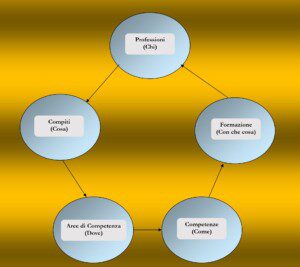The Skills Cycle for the Construction of Professional Profiles and Training Standards

Reference page: Tourism, Arts and Heritage Competence Framework: “Tourism, Arts and Heritage Competence Framework (TAH-CF)”
This document is a summary extracted from the book “The Cycle of Skills for the Construction of Professional Profiles and Training Standards” by Ignazio Caloggero – 2023 Edition Centro Studi Helios – ISBN: 9788832060256. The paper book is on the market (on Amazon, it can also be purchased with the Culture Bonus and the Teacher's Card Bonus. To facilitate the reading of the volume by scholars and interested parties, it is possible to download the volume for free from the ACADEMIA.EDU website at the following web address: https://www.academia.edu/108526521/
1. On the concept of Competence
Competences, understood as the ability to use knowledge and know-how, represent a combination of knowledge, skills and personal abilities, together with the degree of autonomy and responsibility required to solve problems or carry out tasks, even of a complex nature. In summary, therefore, one competence it is the combination of knowledge, skills and a certain degree of autonomy and responsibility, which allows a person to act effectively and appropriately in a variety of situations and contexts.
The European Qualifications Framework for Lifelong Learning (EQF) provides the following definitions:
Competence (EQF)
Proven ability to use personal, social and/or methodological knowledge, skills and abilities in work or study situations and in professional and personal development. (EQF – Annex 1 definition i).
Autonomy and responsibility (EQF)
The learner's ability to apply knowledge and skills autonomously and responsibly. (EQF – Annex 1 definition h).
The categorization of reference standards for professional qualifications and training acquired in non-formal and informal contexts has traditionally developed following two main approaches:
- Professional Standards (or employment standards). These are based on the logic of employment and focus on the duties, tasks and results obtained in a work context. In essence: "what I am able to do in the workplace"
- Educational Standards (or education/training). These, however, focus on the logic of education and training. They focus on what is learned, how it is learned, and how learning is assessed. In essence, they concern the process of acquiring and evaluating knowledge and skills.
The need to integrate the two types of standards has been felt for years as these standards are not essentially separate entities (world of education and work), this has meant that the training standards have undergone a conceptual evolution over the years that would allow this integration.
Training standards, which were traditionally formulated in terms of learning inputs (such as disciplines, training contents, study programs and methods of training delivery), have evolved towards a definition based on learning outcomes. These results, obtained at the end of the learning path, are expressed in terms of Knowledge, Skills, Responsibility and Autonomy. Attention, therefore, has shifted not so much to the structure of the training path necessary to obtain a qualification, but rather to the skills actually acquired at its completion.
The convergence and integration promoted by European standards, such as EQF and ECVET, have led to the definition of standards related to learning (both formal, non-formal and informal) expressed in terms of Knowledge, Skills and Autonomy and Responsibility. These represent both professional standards (referring to the world of work) and training standards (referring to the world of training). The key element that connects these two standards are skills, which, as we have seen, are defined by the trinomial "Knowledge, Skills and Autonomy and Responsibility". These skills represent both learning outcomes and the requirements necessary to carry out specific work tasks.
This approach helps ensure that what is learned through training courses is directly applicable and relevant to the world of work, thus facilitating the transition from education to work and helping to reduce the gap between acquired skills and skills required by the labor market .
2 The Skills Cycle
A useful tool for the integration of professional (SP) and training (SF) standards is precisely the model that I have called "Skills Cycle"
The proposed Competence Cycle is based on the following elements (or phases):
- 1) Identify the Profession (Who): The reference set is the Professions (P), which is to be understood as a dynamic set that photographs the state of affairs at a given moment of the world of professions; therefore, it is susceptible to continuous evolution.
- 2) Define the Tasks (What): The reference set is the Tasks (Tasks). For each profession, it is essential to define the specific tasks and activities that characterize the relevant professional role
- 3) Identify the Areas of Expertise (Where): The reference set is the Areas of Competence, which contain the individual thematic sectors of competence, within which the skills necessary to carry out the tasks and activities assigned to the profession can be identified.
- 4) Identify the Skills (How to): The reference set is the skills (Skills), which once the associated task has been specified, are in turn defined through the following components:
- Additional required knowledge: (Knowledge) (Know)
- Ability (cv) (Know how to do or ability to apply knowledge)
- Level of Autonomy and Responsibility (responsibility and autonomy level): Required level of ability to apply knowledge and skills independently and responsibly. This level is associated with one of the eight levels referred to in the QNQ/EQF classification)
- 5) Training (With what): The reference set is the tools, techniques, methods and training programs used to develop or improve the skills identified in phase 4. This is about determining how an individual can acquire or perfect the skills necessary for a particular profession. The training path should be based on the learning outcomes achieved at its end. These outcomes must guarantee the acquisition of the skills necessary to carry out the tasks associated with the professional role taken as reference. Training can be initial, to obtain skills, or refresher, to maintain them; hence the cyclical nature of the phases described
The phases of the Skills Cycle, such as the identification of the profession, the definition of tasks, the identification of areas of competence and the skills themselves, as well as training, are all interconnected and influence each other. The Skills Cycle can be seen as a bridge between the world of education and that of work. It provides a framework for identifying, defining and developing skills that are both relevant to the needs of the labor market and based on a solid educational and training foundation.
The connection between the phases of the Skills Cycle and the professional and training standards is therefore as follows:
- Professional Standards (SP)
- Identifying the Profession (Who)
- Define the Tasks (What)
- Identify Areas of Expertise (Where)
- Identify Skills (How to)
- Training Standards (SF)
- Training (with what)
3 Identify the Profession (Who)
It involves identifying a list of professions which will constitute the starting point of the process of building professional profiles since for each profession it is necessary, once the specific tasks and activities have been identified, to formalize the set of skills necessary to carry out the tasks required by the profession.
The list of Professions is not normally static but is to be understood as a dynamic whole that photographs the state of affairs at a given moment of the world of professions in the Sector taken as reference.
The tourism and cultural sector is a clear example of how technological evolution and changing market demands can lead to the birth of new professions. For example: Travel Designer, Cultural Event Manager, Heritage Social Media Manager, etc.
Who are the Professionals
However, a first distinction in the classification of professions is to consider the following two classes:
- Regulated Professions: Professions which, in order to be legally exercised in a specific jurisdiction or country, require compliance with certain rules or criteria established by law (e.g. Doctors, Engineers, Pharmacists, Lawyers, Notaries, Architects, etc.).
- Unregulated Professions: Professions for which there are no specific regulations or legal requirements that regulate access to or exercise of the profession (Experiential Tourism Manager, Destination Manager, Photographer, Wedding Planner, Artists, Archaeologist, Demo-ethnoanthropologist, Art Historian, etc. ).
La 4 / 2013 law in Italy, it introduced a regulatory framework for professions not organized into orders or colleges. This law aims to recognize and enhance unregulated professions, while guaranteeing the quality of services offered to the public through continuous training and compliance with a code of ethics.
It is worth remembering that the classification of professions as regulated and unregulated may vary from one country to another and from one jurisdiction to another. These differences can be influenced by various factors, including local regulations and labor market dynamics or corporate pressures. In addition, it is interesting to observe how some professions, originally not subject to particular regulations, can evolve and become regulated over time. These changes may be the result of new laws introduced to respond to particular industry needs or concerns, or to ensure higher quality and safety standards for consumers and professionals themselves.
It is equally true that some regulated professions can become UNregulated, see in this regard the specific case of Nature Guides in Sicily, the profession was initially regulated by a regional law. However, with regulatory changes, it has become an unregulated profession, and now falls under the context of Law 4/2013. This means that, although they are no longer subject to specific regional regulation, Nature Guides can still practice their profession by following the guidelines and requirements established by Law 4/2013.
Professionals in Italian regulation
The Prime Ministerial Decree of 14/10/2021, known as the "Recruitment Decree" and published in the Official Journal no. 268 of 10/11/2021, provides for the first time a legal definition of "professional". This decree identifies the professionals who are authorized to submit applications on the recruitment portal to obtain professional positions in public administrations.
For the purposes of the decree, the following is meant: "professional": the natural person registered in a register, college or professional order and the professionals as defined pursuant to art. 1 of the law of 14 January 2013, n. 4, in possession of the certificate of quality and professional qualification of the services pursuant to art. 7 of the law of 14 January 2013, n. 4, issued by a professional association included in the list of the Ministry of Economic Development, or in possession of certification in compliance with the UNI technical standard pursuant to art. 9 of the law of 14 January 2013, n. 4 (Art. 1 Prime Ministerial Decree 14/10/2021).
In summary, according to the Prime Ministerial Decree of 14/10/2021, the recognized "professionals" are:
- Professionals registered in a professional register, college or association;
- Professionals who hold a Quality and Professional Qualification certificate, issued according to Law 4/2013;
- Professionals certified according to UNI technical standards.
For all professional figures for whom there are no registers and considering the European trend of not encouraging the creation of new national registers due to the difficulties of recognition at European level, the only options available for the recognition of professional requirements, in compliance with the legislation currently in force, at least in Italy, are the certification according to Law 4/2013 or the UNI certification.
4 Define the Tasks (What)
For each profession taken as a reference, it is essential to define the tasks (Tasks) and the specific activities that characterize the relevant professional role. They provide an overview of the main activities and objectives that a professional must achieve.
A task is usually defined by a verb describing an action that is accompanied by the object or goal on which that action is focused.
I tasks indicate the main responsibilities or functions that a professional is called upon to carry out in his role. The specific activitiesinstead, they represent the detailed actions taken to complete those tasks.
5 Identify Areas of Expertise (Where)
The reference set is the Areas of Competence, which contain the individual sectors or domains in which a professional figure must be competent to effectively carry out his tasks and activities. These areas of expertise act as “containers” that bring together related skills.
Each Area of Competence can include several specific skills that are essential to carry out certain tasks or activities within that specific area.
The Areas of Competence contain the individual sectors of competence within which the Thematic Competencies are identifiable. The latter, referring to the different sectors, are the components that can contribute to the definition of professional profiles. A single Thematic Competence can be an integral part of multiple professional profiles.
It is not easy to define an exhaustive list of skill areas that includes the countless existing professions, a non-exhaustive list for the Tourism and Cultural Sector is indicated in the SP/ TAH-CF Professional Standard cited in the in-depth information.
A working hypothesis that I would recommend is to start from macro areas such as:
- CTB Area Basic or context skills (what)
- CTQ Area Quality Management Skills and Management Systems (how)
- CTS Specialist Skills Area (with which specific tools)
- CTT Transversal Skills Area (with which transversal tools)
The areas are derived from a reasoning that aims to provide an initial answer to the following questions:
- What: The reference context that constitutes the starting point in which individual professionals operate. This area represents the foundation on which a profession is based. It is essential to have a clear understanding of the context in order to operate effectively in a given sector. For example, in the Tourism and Cultural Sector some basic areas of expertise could be: Cultural Heritage, Theatre, Dance, Cinema, Television, Music, Painting, Sculpture, Photography, etc.)
- How to: How to promote and manage activities related to professions. Quality Management and Management Systems are the glue that allows quality management of specific tasks and activities linked to individual professions. It includes skills such as planning, monitoring, evaluation and continuous improvement.
- With which tools: The tools, in this phase, are divided into two further areas:
- Specific (SP): These skills are closely linked to the specific sector and represent the skills and knowledge necessary to carry out specific tasks. Still in the Tourism and Cultural Sector, some tools could be: Tourist and Territorial Marketing, Hiking, Environmental Education and Sustainable Development, Experiential Tourism, Museology, Ecomuseology, etc.).
- Transversal (ST): Intersectoral area of expertise. The associated skills can be applied in a variety of professional contexts and are not tied strictly to a specific profession or industry.
6 Identify Skills (How)
The skills (capacity of use knowledge and know-how) constitute a combinatorial element that takes into account the knowledge, ability e personal abilities and the relative degree of autonomy and responsibility needed to solve a problem or carry out a task task also complex.
The skills, once the associated task has been specified, are defined through the following components:
- Additional required knowledge: (Knowledge) (Know). They refer to the information or facts that a person knows in a particular field or industry.
- Ability (cv) (Know how to do or ability to apply knowledge). They refer to the ability to apply knowledge in a practical way to carry out tasks or solve problems
- Level of Autonomy and Responsibility (responsibility and autonomy level): Required level of ability to apply knowledge and skills independently and responsibly. This level is associated with one of the eight levels referred to in the QNQ/EQF classification)
The level Autonomy and Responsibility QNQ/EQF correspondence should be associated for each individual competence. As a rule, with the exception of some e-CF professional figures, this does not happen, as the overall QNQ/EQF level given to the professional figure as a whole is provided. This is done to simplify and provide a single EQF value and is possible thanks to the application of the principle of the "qualitative principle of prevalence".
The qualitative principle of prevalence is also reported in Annex 2 "Minimum criteria for the referencing of Italian qualifications to the National Qualifications Framework" of the MLPS - MIUR Decree 08/01/2018 "Establishment of the national qualifications framework issued within the System national certification of skills referred to in Legislative Decree 16 January 2013, n. 13”
"In the event that the qualification presents skills with different levels or different levels with respect to the dimensions or descriptions of the NQF and in any case, in the more comprehensive process of comparative and coherence assessments referred to in this point, the referencing must always take place on the basis of the qualitative principle of prevalence, attributing the most recurring level to the qualification".
In other words, if a qualification has a variety of skills that span different levels, rather than assigning an average level or trying to balance between different levels, the level that is most frequently represented or that is predominant is used as a reference for the qualification as a whole.
The result, consequent to the application of the "qualitative principle of prevalence" is therefore that many rules, including the Recent UNI standards for the definition of professional profiles, represent the individual skills through the following components:
- Additional required knowledge: (Knowledge)
- Ability (Skill)
And they report a single EQF level referable to the profession
It should be noted that the UNI standards issued until mid-2021 report a trio composed as follows:
- Additional required knowledge: (Knowledge)
- Ability (Skill)
- Skills (C)
The skills are here explained in ways similar to skills, creating, in some cases, confusion between the terms "skills" and "skills" which led to a sort of terminological overlap. This aspect is probably linked to the fact that in the 2008 EQF, in the table of Annex II (Descriptors defining the levels of the European Qualifications Framework (EQF), the term "skills" was used instead of "autonomy and responsibility".
Identification of Skills and type of Professions
When identifying the skills associated with a specific profession, it is necessary to take into account whether this profession is regulated or not, as the former have specific requirements established by law, while the latter may vary based on technical standards, reference practices or schemes proposed by interested parties.
Here is a first classification:
- A) Regulated profession: Competences are (or should) be defined by the legislation governing the profession. In this case you MUST refer to the provisions of the legislation in the jurisdiction or country in which the profession has been regulated (Engineers, Doctors, Architects, Alpine Guides, etc.).
- B) Profession not regulated but built on the basis of a technical standard or reference practice. The skills are defined by technical standards, such as the ISO, EN or UNI standards or reference practices such as the UNI PdR in Italy. In this case it is necessary to refer to the published technical standards where you are interested in third-party certification or recognition pursuant to the published PdR.
- C) Profession not regulated but built on the basis of a regulatory reference. The skills are defined on the basis of regulatory references defined at a national or jurisdictional level or by sheets defined by Public Bodies (for example, in Italy, the sheets of Cultural Heritage Professionals defined pursuant to Ministerial Decree 244 20/05/2019: Archaeologist, Demoethnoanthropologist, Art Historian, etc.). In this case it is necessary to refer to the published technical standards where there is an interest in recognition by the Public Body that issued the regulatory reference.
- D) Profession not regulated and established on the basis of a scheme proposed by an interested party (Stakeolder). In this case it is necessary to refer to the proposed scheme where there is an interest in recognition of the interested party. In Italy, for example, this is the case of the recognition schemes published by Professional Associations authorized to issue certification pursuant to Law 4/2013.
- E) Unregulated profession and there is no reference scheme. In this case, you are free to define the skills, ensuring that they are consistent and relevant with the profession taken as reference.
The competences necessary for a profession, including skills and knowledge, represent a dynamic set, subject to changes over time due to factors such as technological evolution or other sectoral developments. Consequently, the schemes developed for individual professions will have to be subject to continuous revisions and updates over time.
7 Training (With what)
We have seen phase 5 of the skills cycle as that of Training, where the reference set is the tools, techniques, methods and training programs used to develop or improve the skills identified in phase 4.
In essence we are therefore talking about training courses, which we have said must be based on the concept of learning outcomes. These outcomes must guarantee the acquisition of the skills represented by the trinomial "Knowledge, Skills, Autonomy and Responsibility", necessary to carry out the tasks associated with the professional role taken as reference. Training can be initial, to obtain skills, or refresher, to maintain them; hence the cyclical nature of the phases described.
A training path can be seen as a process and should be described through a scheme that includes at least the following elements (or phases).
Phases of the Training Process
- 1) Identification of learning outcomes: which we remember are defined in terms of knowledge, skills and autonomy and responsibility. This is the fundamental phase in which training objectives are established.
- 2) Identification of Capitalizable Units: This phase concerns the structuring of the training path into teaching units or modules. Each unit should have specific objectives and contribute to achieving the general objectives of the path. Each unit must be defined in legible and understandable terms and should be as "self-supporting" as possible, in the sense of independent from the other units, just as in theory the teaching contents should refer to specific skills
- 3) Evaluation of the quality provided: identification of the tools for monitoring the quality of the training provided
- 4) Evaluation of learning outcomes: This involves identifying the methods and processes used to evaluate learning outcomes.
- 5) Recognition of learning outcomes: This phase concerns the formal recognition of the skills acquired. In these cases it is necessary to distinguish at least between: Formal Learning (Certification of skills) and Non-Formal and Informal Learning (Third-party Certification/Attestation)
The advantages of the indicated scheme are various and among them:
- Learning Outcomes.It allows training courses to be defined in terms of learning outcomes, which indicate precisely what those in possession of the final certificate issued at the end of the training course know and are able to do.
- Transparency and Recognizability.It guarantees greater transparency, recognizability of the contents and learning outcomes.
- Modularity and Flexibility.The use of capitalized units that are also "self-supporting" and independent reflects a growing trend in training towards modularity and flexibility.
- Common language.Use of a common language that facilitates mutual recognition of training paths between interested parties.
- Transfer of Expertise.The transfer of capitalized units allows a person to make use of the skills acquired even when the interested party changes his or her learning path or professional specialization.
- Link between Formal and Non-Formal Learning.It allows for a better connection between formal, non-formal and informal learning.
- Connection between the world of work and the world of education.Integration with the Competence Cycle allows for a better connection between the world of work (tasks) and the world of training (learning outcomes).
In reality, precisely to take into account the independence of the Teaching Units, a certain degree of "redundancy" will have to be accepted in the sense that the contents of a teaching unit will serve to acquire different skills and the same skills may appear in multiple teaching units. This means that even the skills evaluation process cannot always be carried out at the level of a single teaching unit but, in some cases, moved forward in the training path, sometimes at the end with subsequent activities (Project Work, Thesis, Work Internships, written and oral final exams).
The training paths to which the phases of the training process presented can be applied are essentially of two types:
- Professionalizing training courses: Training courses, generally of medium and long duration, which provide complex skills whose exiting professional profiles are referable to specific professionalisms. Students who complete these pathways are generally ready to enter the world of work directly in specific roles. These paths may include internships, project work, and other practical experiences that allow students to apply the skills learned in real-world contexts.
- Basic training courses: Training courses, generally short, which provide basic skills, based on individual themes that one or more professionals may possess and which contribute to the creation of the skills that the various professional profiles must have. Refresher courses, essential for professionals who want to stay up to date on the latest trends and innovations in their field, also fall into this category.
Both types of paths have a fundamental role in the training system. While professionalization-oriented paths provide the skills necessary for specific careers, basic paths constitute the tool for constant and lasting learning. The latter is particularly strategic in a constantly changing work context, where the necessary skills evolve rapidly.
7.1 Identification of learning outcomes
Learning outcomes
In this regard, it may be useful to remember the provisions of the EQF and ECVET standards
Learning outcomes (EQF): Description of what a person knows, understands and is able to achieve at the end of a learning process.
Outcomes are defined in terms of knowledge, ability e autonomy and responsibility. Learning outcomes can arise from formal, non-formal or informal learning
Learning outcomes (ECVET): The indication in terms of knowledge, skills and competences of what a beneficiary of training knows, understands and is able to do once he has completed a learning process. (ECVET, Annex I, definition b)
Note: “Learning outcomes” in the 2017 EQF version are no longer “defined in terms of knowledge, skills and competences”, but “in terms of knowledge, skills and responsibilities and autonomy”. This is a formal rather than substantial clarification, as already in 2008 it was specified that "in the context of the European Qualifications Framework, skills are described in terms of responsibility and autonomy".
Credit for learning outcomes (ECVET credit): A set of learning outcomes achieved by a person which have been assessed and which can be accumulated towards a qualification or transferred to other learning programs or other qualifications. (ECVET, Annex I, definition d)
Professionalizing training courses
In the case of a training course necessary to acquire the skills necessary to carry out the tasks associated with a specific professional profile, the set of learning units represents the learning outcomes essential for practicing the profession outlined by the profile itself. It is essential to start from the assumption that the professional profile has been developed in compliance with phases 1-4 of the Skills Cycle. In this scenario, the skills have already been defined within the profile, making the objective of the training path extremely clear: to equip the individual with the skills necessary to carry out the specified professional role.
The title of the Training Path should, therefore, uniquely and precisely identify the path itself, including an explicit reference to the relevant profession.
Basic training courses
In the case of a basic training course, it is still useful to identify the objectives by specifying which thematic skills are provided or updated at the end of the course. In cases where the basic courses constitute the individual teaching units (or units that can be capitalized) that contribute to providing the skills in a professionalizing training path, it could be useful to assign an EQF level to define the level of autonomy acquired for the skill taken into consideration. In fact, different training paths sometimes have teaching units (subjects) in common but with a different degree of depth depending on the type of professionalism acquired.
In fact this rarely happens because, as already mentioned, the qualitative principle of prevalence applies, whereby the overall EQF level is only assigned to the professional figure as a whole.
It is not usual to provide the EQF level for refresher courses as they tend to be focused on specific areas and may not cover the full range of skills required for a given EQF level.
For both professional and basic courses it may be useful to indicate what are called i entry prerequisites.
The entry prerequisites necessary for attending the training course should be divided into:
- Mandatory prerequisites: mandatory prerequisites that take into account the formal training (education qualifications) and the non-formal (specific training) or informal training (work or professional experience) necessary to access the path.
- Recommended prerequisites: Non-mandatory prerequisites but which can be useful for a better understanding of the topics covered in the proposed training course
- No prerequisites: in this case the training course is accessible to everyone regardless of previous knowledge or qualifications
7.2 Identification of Capitalizable Units
This phase concerns the structuring of the training path into teaching units or modules. Each unit should have specific objectives and contribute to achieving the general objectives of the path. Each unit must be defined in legible and understandable terms and should be as "self-supporting" as possible, in the sense of independent from the other units, just as in theory the teaching contents should refer to specific skills
Professionalizing training courses
In the case of a training course whose objective is to acquire the skills to carry out the tasks associated with a specific professional profile, the set of units that can be capitalized (learning units or teaching units) constitute the learning outcomes necessary to carry out the profession identified by the profile.
The Capitalizable Units (“UD” Teaching Units) should be structured in such a way as to respect the following characteristics:
- be readable and understandable, indicating the teaching program comprehensively;
- be, as far as possible, "self-supporting", in the sense of independent from the other units;
- assessable;
Duration of the course
The information on the duration of the individual Teaching Units and consequently of the entire training course should allow us to identify the actual hours of attendance and the overall hours of commitment necessary to obtain the learning results.
The actual hours of attendance are established by the lessons and the internship, work placement or project work activities where applicable.
The hours of total effort (workload) must also take into account:
- Exercises, preparation of papers or personal study
- Preparation and conduct of exams
- Seminars
- Company visits
The workload is an estimate of the time needed to achieve the learning outcomes expected for the training course. However, it should be kept in mind that this number of hours is to be understood as an average learning time, and represents a workload considered normal to achieve the learning results and which may vary from student to student.
The problem arises of how to estimate the total commitment in relation to actually quantifiable activities such as teaching lessons, internships or laboratory activities. It is proposed to use, also for the ECVET (Non-Formal Training) standard, a scheme similar to that used in the ECTS (Formal Training) standard
In the university environment, these are generally the parameters used:
- 1 hour of frontal lessons corresponds to 3 hours of actual individual commitment
- 1 hour of laboratory practice corresponds to 2 hours of effective individual commitment
- 1 hour of apprenticeship or internship corresponds to 2 hours of effective individual commitment
For example, a university subject that involves 50 hours of lessons (between lectures and classroom exercises) normally involves a total commitment of 150 hours and a corresponding 6 CFU (University Education Credits). Each CFU corresponds to 25 hours of total commitment).
In reality, the parameter linked to the frontal lessons should take into account the degree of difficulty encountered by the student in learning the concepts taught within the lessons, but this is not entirely simple as it would be necessary to analyze a series of parameters and variables that are not always quantifiable. objectively. For example, for each teaching unit we should calculate the estimated learning time, the overall duration, requests for in-depth analysis or exercises from teachers, and more.
A compromise could be to "mediate" between the various elements, for example, a Didactic Unit with a total duration of 20 hours could be compared, in terms of overall load, considering three distinct levels of difficulty:
- Didactic unit of high difficulty: multiplier parameter 3 => 20*3 = 60 total hours of effort
- Medium difficulty teaching unit: multiplier parameter 2 => 20*2 = 40 total hours of commitment
- Didactic Unit of low difficulty: multiplier parameter 1 => 20*1 = 20 total hours of effort.
As you can see, the highest value of the parameter corresponds to what is normally used in university teaching based on the ECTS system (formal learning)
A comparison could be made by assigning the parameters to the various subjects of a training course according to the type of course (basic, medium advanced) even if in any type of course there will always be teaching units with a different level of learning difficulty
Basic training courses
For basic or refresher courses it is sufficient to indicate the teaching program which explains the knowledge acquired at the end of the unit.
In cases where the basic courses constitute the individual teaching units (or units that can be capitalized) that contribute to providing the skills in a professional training course based on the ECVET system, it is advisable to indicate the number of credits associated with the individual unit.
The total number of ECVET credits assigned to the entire path is linked to the total hours of commitment (workload) necessary to obtain the learning outcomes expected in all UDs
7.3 Evaluation of the quality provided
Professional and basic training courses
The quality of the training provided should be assessed using specific internal quality procedures and customer satisfaction questionnaires to be provided anonymously if possible.
Depending on the complexity and duration of the training course, one or more of the following elements should be taken into consideration:
- Use of a procedure that defines the methods of monitoring the quality provided and the administration of Customer Satisfaction questionnaires
- Use of a procedure that defines the methods for managing non-conformities and corrective actions
- Use of a procedure that defines the factors, quality indicators and certified standards and the methods of analysis of the data collected during the Quality monitoring and detection activities
- Delivery of a satisfaction questionnaire provided for each individual teaching unit
- Delivery of a satisfaction questionnaire delivered at the end of the training course
7.4 Evaluation of learning outcomes
It may be useful to remember the following definition.
Assessment of learning outcomes (ECVET): The methods and processes used to define the extent to which a person has actually achieved a particular knowledge, skill or competence. (ECVET, Annex I, definition f)
For the evaluation of learning results it is appropriate to distinguish the cases of
- Formal Learning: the methodologies and actors for those interested in the evaluation of formal learning are established by legislation (for example Diploma, Degree, State exams).
- Non-Formal and Informal Learning. The evaluation of specific training (non-formal training) should however take place using, if possible, recognizable tools
The following refers to the evaluation of learning outcomes associated with Non-Formal and Informal Training.
Professionalizing training courses
The evaluation of the specific training should be carried out by evaluating the Knowledge, Skills and related Autonomy and Responsibility, using, when possible, at least the following evaluation elements:
- Written exam for the assessment of knowledge
- Project work (or internship or internship)
- Oral examination
- Informal learning
Basic training courses
The evaluation in these cases is simpler and the evaluation of the knowledge acquired may be sufficient, possibly through final tests or written assignments.
7.5 Recognition of learning outcomes
Once learning outcomes have been identified and assessed, it is essential to officially recognize them. In this regard, the following definition is relevant:
Recognition of Learning Outcomes (ECVET): The process in which officially achieved learning outcomes are certified through the award of units or qualifications. (ECVET, Annex I, definition h)
In this final step of the process it is appropriate to distinguish the cases of
-
- Formal Learning (Certification of skills)
- Non-Formal and Informal Learning (Third Party Certification/Attestation)
Formal Learning
Formal learning it is, as a rule, what happens within the educational system of education and training, and culminates with the issuing of qualifications with legal value. For example: certificates or certificates of professional qualification issued by the Regions or by bodies accredited by them; diplomas issued by professional institutes or other secondary school institutions; other qualifications awarded by higher education institutions, such as universities or AFAM institutes.
Non-formal learning
Non-formal learning it is essentially what occurs following training courses carried out outside the education and training system. Even if it does not issue qualifications with legal value, it can lead to the acquisition of professional skills and competences. In fact, many of the so-called "unregulated professions" derive from non-formal training courses.
Informal learning
Informal learning it is what occurs through "experiences", which can derive from work, daily family, volunteer or free time activities.
As regards formal learning, I refer to the provisions of current legislation, which refers the skills certification process to the competent authorities.
In the case of non-formal and informal learning, the following terms are generally used:
- Third party certification: term used by personnel certification bodies accredited by Accredia. They "certify" the skills of professionals on the basis of specific UNI standards, which indicate the knowledge, skill, autonomy and responsibility requirements required for specific professions.
- Certification: in Italy, this term is used to define the process of Quality Certification and Professional Qualification of Services provided by professionals pursuant to Law 4/2013. This certification is issued by the Professional Associations included in a special list of the Ministry of Business and Made in Italy (formerly MISE).
To certify the possession of skills, it is proposed to take into consideration methodologies that take into account the following aspects in a non-mutually exclusive manner, i.e. possibly in combination with each other:
- Qualifications awarded in the academic field (Formal Learning)
- Specific Training (Non-Formal Learning)
- Work or Professional Experience (Informal Learning)
Work or professional experience can be demonstrated through various tools including:
- Curriculum Vitae
- Professional portfolio
- Objective placement on the market (awards, regional, national or international recognition)
- Publications (scientific or editorial)
Recognition of informal learning through work or professional experience is essential, as many skills are acquired in the field and not through traditional training paths.
The qualification, generally compulsory in cases of formal learning, is taken into consideration but its weight tends to decrease as the skills acquired in the field increase, as they demonstrate an individual's ability to apply his knowledge in real situations .
Featured










